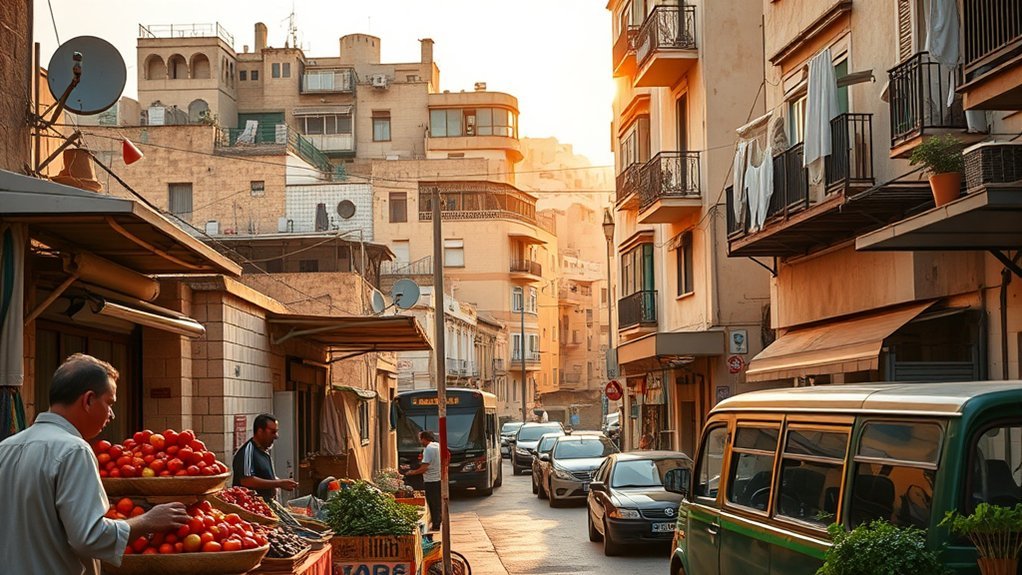You’ll need roughly 700 JOD/month as a single (excluding rent) and about 2,700 JOD/month for a family of four (excluding rent). Central Amman one‑bedrooms average ~330 JOD and three‑bedrooms outside center ~360 JOD; basic utilities add ~78 JOD and internet ~23 JOD. Groceries and transport are affordable—local trips ~0.55 JOD or a 30 JOD monthly pass—while private healthcare and international schools raise costs; keep going for a detailed breakdown.
Cost of Accommodation and Utilities in Jordan
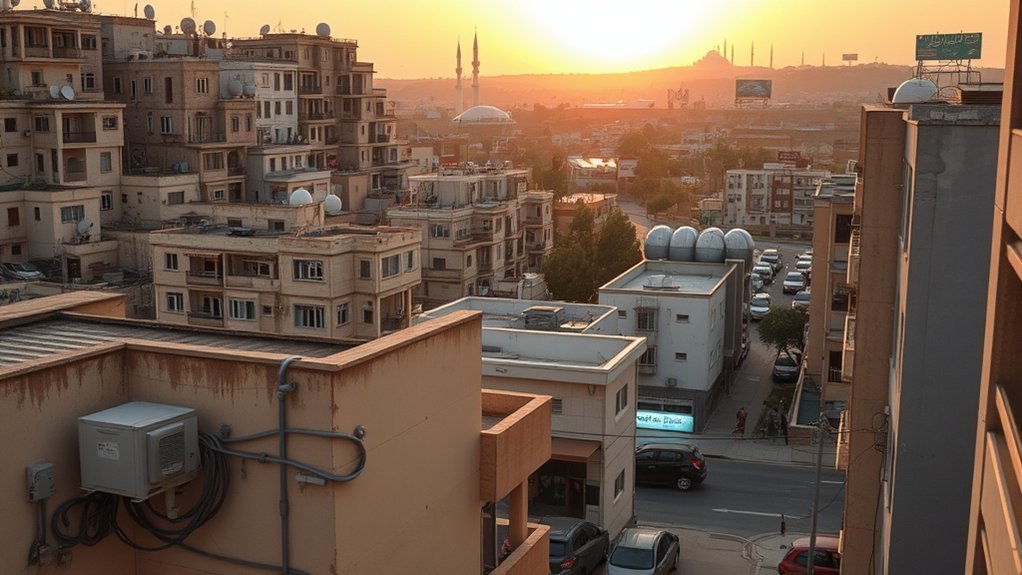
While rents vary by neighborhood, you’ll typically pay about 330.43 JOD for a one-bedroom in central Amman versus roughly 360.23 JOD for a three-bedroom outside the center. This makes central one-bedrooms cost-effective for singles or couples.
One-bedroom apartments in central Amman average ~330.43 JOD, making them a cost-effective choice versus ~360.23 JOD three-bedrooms outside center.
Basic utilities for a 915 sq ft apartment average 78.03 JOD/month (range 48–150 JOD), internet (60 Mbps+, unlimited) runs ~22.91 JOD (20–30 JOD), and seasonal heating can double utility bills in winter. Therefore, opting for fully furnished units—though pricier—often reduces upfront appliance and furnishing costs and simplifies monthly budgeting.
You’ll compare cost of accommodation by weighing rent per square meter, location premiums, and furnished versus unfurnished listings. For utilities, assess historical winter bills and include internet as a predictable line item.
When calculating living costs, prioritize listings that bundle services or include efficient heating; that can lower peak-season exposure. Use the provided averages and ranges to model conservative and optimistic monthly scenarios, then choose housing that matches your cash flow and tolerance for seasonal volatility.
Typical Monthly Expenses for Families and Singles
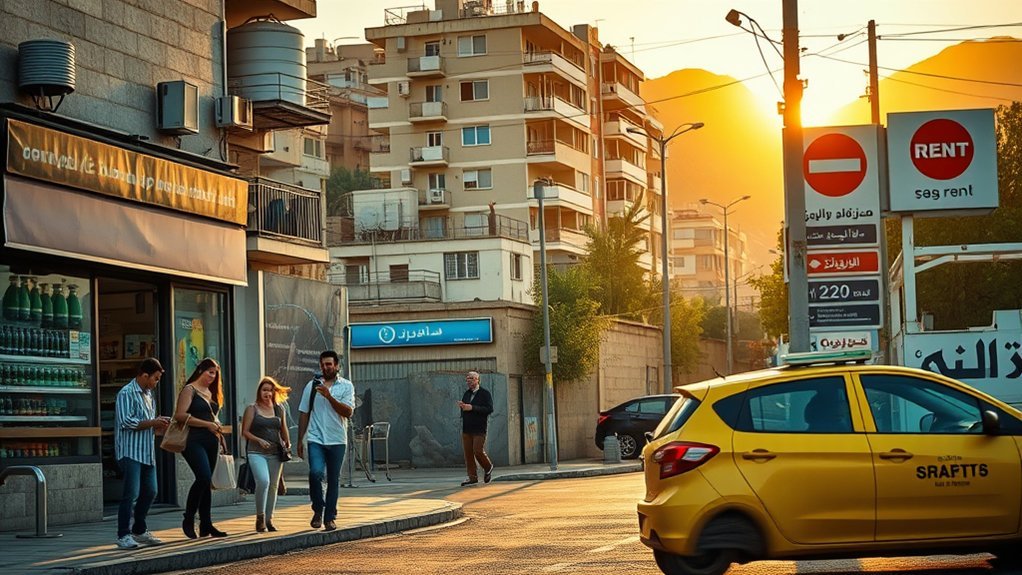
Having weighed rent and utilities, you can now map out typical monthly spending: a single person in Jordan faces about 769.4 JOD (excluding rent), while a family of four averages roughly 2,718.1 JOD (excluding rent).
Those figures frame the broader cost of living and help you compare living in Amman versus other cities. Utilities add about 78.03 JOD monthly; transport runs ~0.55 JOD per ride or 30.00 JOD for a monthly pass. Dining, healthcare, schooling and entertainment drive the gap between single and family budgets.
- Singles prioritize transport, utilities, occasional dining; estimated monthly costs center on convenience and lower consumption.
- Families absorb higher groceries, healthcare, education and leisure costs, pushing totals toward the 2,718.1 JOD mark.
- Rent remains a separate decision variable: central one-bed or suburban three-bed choices alter total monthly burden.
Use these benchmarks to forecast budgets and negotiate salaries or rental choices when living in Amman.
Grocery and Food Prices Across Cities
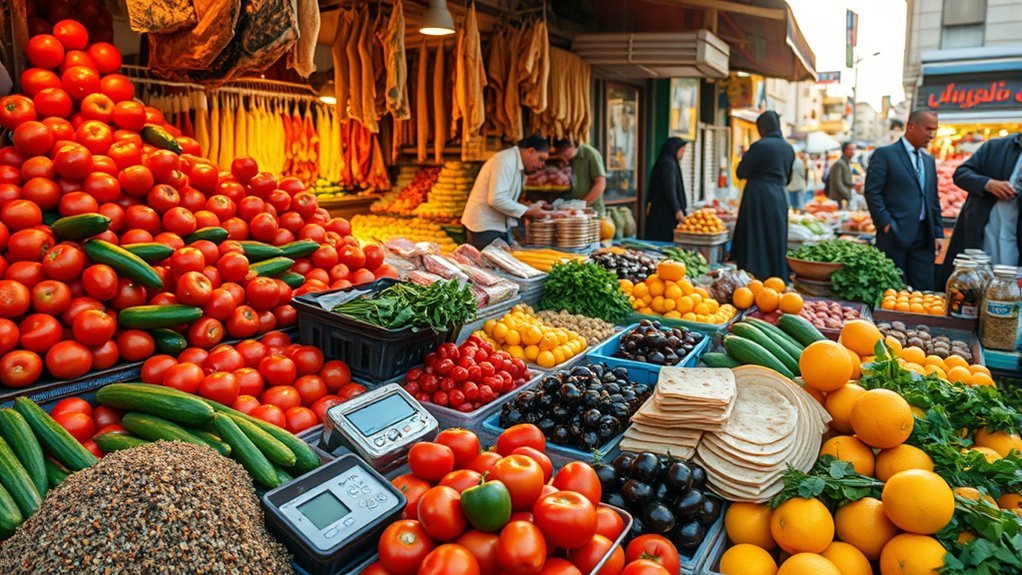
Grocery costs across Jordan vary by city but follow clear patterns you can use for budgeting: staple items — 500 g boneless chicken at about 3.725 JOD, 1 L whole milk at 1.187 JOD, a dozen large eggs at 2.028 JOD, 1 kg tomatoes at 0.536 JOD, and 500 g local cheese at 5.456 JOD — give a snapshot of food-price differentials between Amman and smaller cities, with urban centers typically showing slightly higher prices for dairy and meat and marginally lower produce prices due to supply chain advantages.
| Item | Typical price (JOD) |
|---|---|
| 500 g chicken | 3.725 |
| 1 L milk | 1.187 |
| 12 eggs | 2.028 |
| 1 kg tomatoes | 0.536 |
| 500 g local cheese | 5.456 |
You’ll find living costs tied to location: choose Amman for wider choices and marginally higher meat/dairy costs, or smaller cities for cheaper staples and fewer premium options.
Transportation and Commuting Costs
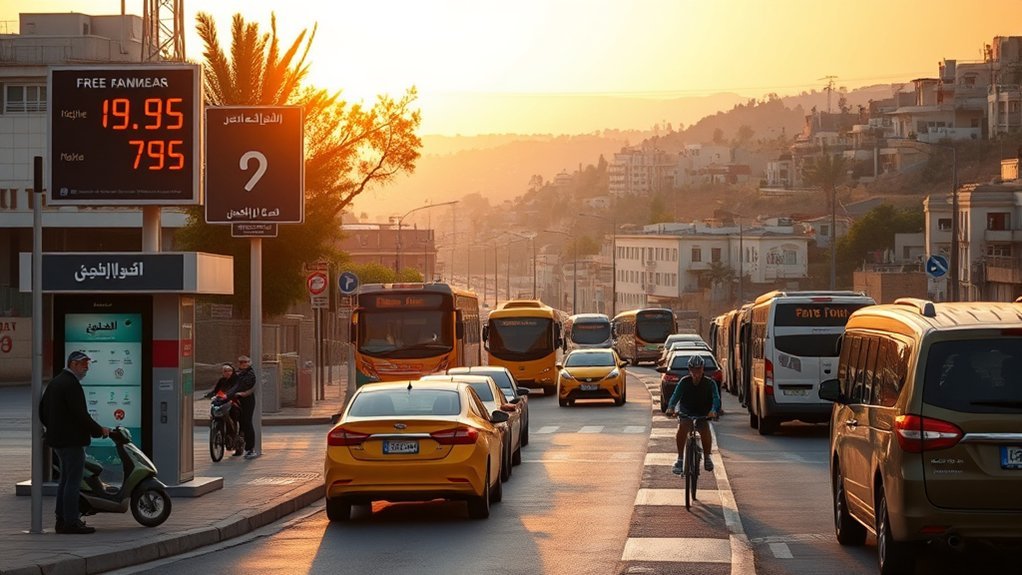
Because commuting costs hinge on how you travel, budget about 0.55 JOD per one-way local trip or 30.00 JOD monthly for regular riders. Taxis start near 0.50 JOD but can overcharge, so agree fares in advance. Drivers should factor in roughly 3.61 JOD per gallon for petrol plus urban parking fees.
Budget about 0.55 JOD per one-way trip or 30 JOD monthly; taxis and fuel (3.61 JOD/gal) vary.
You’ll find transportation options vary in reliability and cost, so compare public transit, taxis, and driving when estimating living in Jordan expenses. Public buses are cheapest but less predictable; a monthly pass smooths commuting budgets. Taxis offer flexibility but carry negotiation risk and occasional higher fares.
Driving gives control; fuel at 3.61 JOD/gal and parking can push monthly totals above transit subscriptions. Use these figures to model your commute and choose the most cost-effective mix for time versus money.
- Local one-way: ~0.55 JOD
- Monthly pass: ~30.00 JOD
- Taxi start: ~0.50 JOD (negotiate)
- Fuel: ~3.61 JOD/gal plus parking
Healthcare, Insurance and Medical Expenses

When comparing public and private care in Jordan, you’ll find public hospitals offer good quality treatment free for citizens, making them the cheapest option for basic needs.
Private clinics are affordable too — a typical doctor visit runs around 23 JOD and prescriptions like common antibiotics cost about 13 JOD — but many expats buy international insurance to access faster specialist care and broader coverage.
We’ll now compare cost, wait times, and insurance options so you can decide which mix of public/private services and coverage fits your budget.
Public Vs Private Care
One clear choice you’ll face is whether to rely on Jordan’s free public healthcare—which delivers acceptable basic services—or to pay for private care that offers higher quality but higher costs.
You’ll weigh service level against outlay: public healthcare is accessible and cost-free for basic needs, while private healthcare attracts expatriates seeking faster, higher-standard treatment. A private GP visit averages ~23 JOD; a 12-dose antibiotic box ~13 JOD.
Consider these points:
- Cost: public healthcare = no direct charge; private visits and meds add predictable fees.
- Quality & speed: private healthcare generally faster, better facilities; public sufficient for routine care.
- Usage by expatriates: many choose private care and international insurance to avoid out-of-pocket spikes.
- Decision impact: your budget and risk tolerance determine the balance.
Insurance Coverage Options
If you want predictable access to Jordan’s high-quality care, getting health insurance is essential: private plans—especially international policies common among expats—tend to cover routine check-ups, specialist visits, emergencies and medications that public services may not fully reimburse, while relying solely on public care keeps direct costs low but increases wait times and potential out-of-pocket exposure for higher-level treatment.
You should compare premiums, deductibles and provider networks: private healthcare delivers faster access and amenities at higher monthly costs, while public schemes minimize premiums but may require co-payments for certain services.
Many expats choose international health insurance to mirror home-country coverage. Quantify annual premiums against expected usage and negotiate employer support or allowances to offset private plan costs.
Education, Childcare and Schooling Costs

When planning family expenses in Jordan, you’ll find public schools are free and compulsory for basic education while private and international schools often charge well over 2,000 JOD per year.
Many expat families negotiate education allowances to cover high international tuition, which typically offers higher quality facilities and varied curricula.
Childcare and nursery fees sit lower on the scale, commonly between 100 and 300 JOD per month depending on services.
Public Vs Private Schools
Although public schools in Jordan are free and compulsory, you’ll often find parents—especially expats—choosing private or international schools for perceived higher quality, bilingual instruction, and smaller class sizes; expect annual tuition from about 2,000 to 10,000 JOD per child, with many expatriates negotiating education allowances from employers to cover these costs.
You’ll weigh cost versus outcomes: public gives no tuition fees but larger classes and a national curriculum; private schools charge significant tuition fees yet often deliver bilingual programs and lower student‑teacher ratios favored by expatriate families.
- Public: free, standardized curriculum, larger classes.
- Private: 2,000–10,000 JOD, bilingual options, smaller classes.
- Employers: common source of education allowances.
- Decision: budget, language needs, perceived quality.
International School Fees
Because international schools in Jordan follow British, American or international curricula and cater mainly to expatriates, you’re likely to pay substantially more than for local private schools—typically 4,000–20,000 JOD per year depending on grade and institution.
You should budget not just tuition fees but registration, uniforms and extracurriculars, which can add several hundred to a few thousand JOD annually.
Spaces are limited, so early application is common; delayed planning can force you into higher-cost alternatives.
Compared with local private options, international schools deliver familiar curricula for expatriate families but at a 2–5x premium.
If you’re employed, negotiate an education allowance—many employers factor tuition fees into expat packages.
Compare schools by total annual cost, availability and curriculum fit before committing.
Childcare and Nursery Costs
After budgeting for international school fees, you’ll want to factor in early-years care: daycare and nursery costs in Jordan average about 210 JOD per month but vary by location and amenities.
You’ll compare that to public kindergarten (free but limited resources) and the high tuition of international schools (3,000–10,000 JOD annually).
Childcare services range widely, so plan for accompaniment costs like extracurriculars (50–100 JOD/month).
- Daycare/nursery: ~210 JOD monthly cost on average, higher in Amman.
- Public kindergarten: no tuition but fewer facilities and longer waitlists.
- Private babysitters: typically 5–10 JOD per hour, useful for irregular care.
- Extras: activities, transport and supplies can add 50–100 JOD/month per child.
Eating Out, Entertainment and Lifestyle Spending
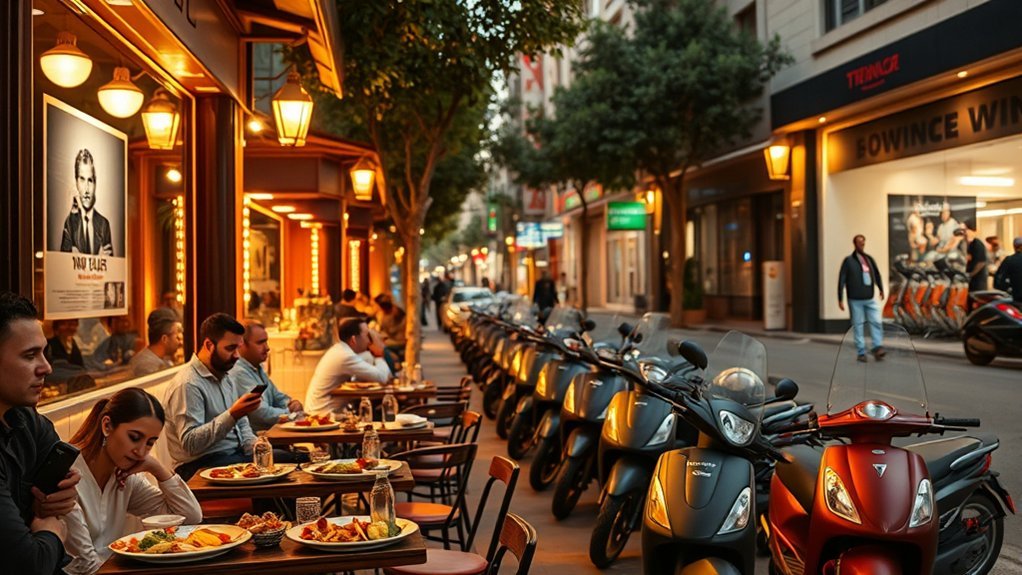
Many everyday social activities in Jordan stay relatively affordable: a basic dinner for two at a neighborhood pub runs about 22 JOD, while a mid-range Italian meal can jump to roughly 53 JOD, and traditional Jordanian dishes typically cost less than international options. When you’re evaluating eating out, entertainment, and lifestyle spending, you’ll find eating out and entertainment are reasonably priced compared with many Western cities. A movie for two is about 17 JOD; top theater seats near 25 JOD. Cocktails average 4.591 JOD, and a pint of domestic draught beer is roughly 4 JOD, so nightlife can add up but stays lower than upscale markets.
| Activity | Typical cost (JOD) |
|---|---|
| Neighborhood pub dinner (2) | 22 |
| Mid-range Italian dinner (2) | 53 |
| Movie tickets (2) | 17 |
| Theater best seats (2) | 25 |
| Cocktail (avg) | 4.591 |
Frequently Asked Questions
Can a US Citizen Move to Jordan?
Yes — you can move to Jordan; you’ll meet visa requirements (arrival or embassy, six-month passport validity), join an active expat community, and manage cultural adjustments; compare options for residency, work permits, and schooling.
How Far Does the US Dollar Go in Jordan?
You’ll find the US dollar stretches well in Jordan: favorable currency exchange lets you get more value, so local spending is cheaper by cost comparison—meals, transport, and groceries often cost considerably less than typical US equivalents.
What Is the Average House Price in Jordan?
Average house price varies, but 1-bedroom city-center rent averages 330.43 JOD, showing rental pressure; you’ll weigh house rental versus property investment, comparing suburbs’ lower costs to the wider housing market data-driven trends.
Is Jordan a Good Place to Live?
Yes — you’ll find Jordan offers strong lifestyle benefits, rich cultural experiences, affordable living versus many Western cities, quality public services, and a growing expat community, making it a practical, enjoyable choice for many residents.
Conclusion
If you’re weighing a move to Jordan, know that a two-bedroom apartment in Amman can cost about 40% more than in Irbid, and utilities add roughly JD 60–90 monthly; that contrast shapes budgets. Families typically spend JD 700–1,200 monthly, singles JD 300–600. Compared to regional capitals, grocery prices stay midrange while transport is relatively cheap. Use these benchmarks to plan: pick location first, then adjust lifestyle and schooling choices to hit your target budget.

